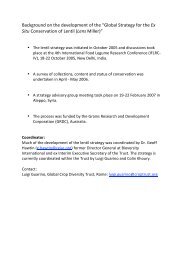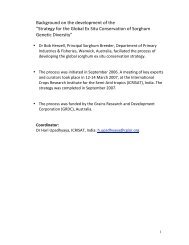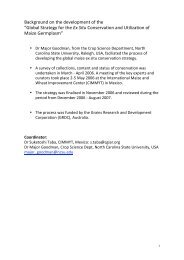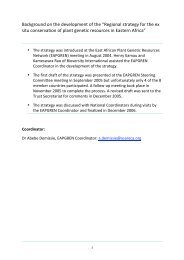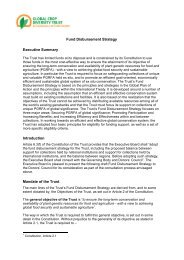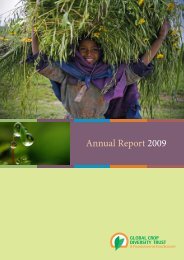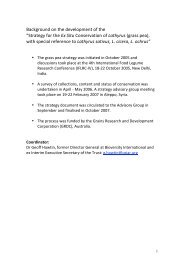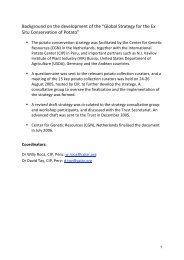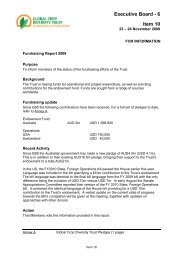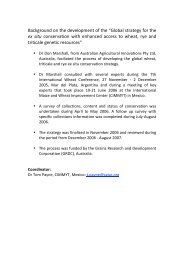Russian wheat aphid (Diuraphis noxia)The Russian wheat aphid, a major pest <strong>of</strong> cereal crops, first appeared in <strong>US</strong>crops in 1986, spurring scientists to develop resistant varieties <strong>of</strong> wheat andbarley. Then, in Colorado in 2003, a possible new biotype <strong>of</strong> <strong>the</strong> Russianwheat aphid emerged, which appears to have overcome <strong>the</strong> genetic defenses<strong>of</strong> many existing wheat and barley lines. Since <strong>the</strong> aphid is known tooriginate in West Asia, scientists are now evaluating large collections <strong>of</strong> wheatfrom that region for resistance.Wheat rust (caused by several Puccinia rust pathogens)Fungal rusts—such as stem, stripe, and leaf—pose ongoing problems for worldagriculture. Although <strong>the</strong> fight against stem rust in <strong>the</strong> 1950s yielded manydisease-resistant varieties <strong>of</strong> wheat, in 1999, Uganda reported a newly virulenttype <strong>of</strong> stem rust. In <strong>the</strong> United States, stripe rust (caused by Puccinastriiformis) devastated wheat crops in <strong>the</strong> Pacific Northwest in <strong>the</strong> 1960s andagain in 2003-4. Repeated epidemics in <strong>the</strong> central Great Plains have occurredsince <strong>the</strong> late 1990s. Fungicide applications may provide control, but at a highcost and with uneven results. Resistant cultivars provide a much betteralternative for controlling <strong>the</strong> stripe rust and o<strong>the</strong>r rust diseases. Current wheatvarieties <strong>of</strong>fer varying levels <strong>of</strong> resistance, however, and scientists are activelypursuing new resistance genes from global sources, including collections inAustralia, Europe, and <strong>the</strong> International Maize and Wheat ImprovementCenter in Mexico (CIMMYT).AppleCENTER OF ORIGIN AND DIVERSITYKazakhstan, Central AsiaECONOMIC VALUEAnnual value <strong>of</strong> <strong>US</strong> production: $1.8 billionThe EnvironmentalProtection Agencyestimates that over300,000 pounds <strong>of</strong>antibiotic pesticides areapplied to fruit treesand o<strong>the</strong>r crops everyyear. <strong>Crop</strong> diversity canhelp supply traits thatcould reduce <strong>the</strong> needfor pesticides.© <strong>US</strong>DA-ARS, Scott BauerSELECT DISEASES OF CONCERN Fire blight (caused by Erwinia amylovora)This bacterial disease infects roughly 75 different plant species, including <strong>the</strong>cultivated apple, pear, and quince. Many favorite apple varieties are highly ormoderately susceptible to fire blight, including Golden Delicious, GrannySmith, Gala, and Jonathan.Growers rely heavily on chemical sprays <strong>of</strong> antibiotic pesticides to ward <strong>of</strong>ffire blight, and <strong>the</strong> Environmental Protection Agency (EPA) estimates thatover 300,000 pounds <strong>of</strong> such pesticides are applied to fruit trees and o<strong>the</strong>rcrops every year in <strong>the</strong> <strong>US</strong>. However, in recent years, fire blight has becomeincreasingly resistant to two major antibiotic pesticides used to protect applecrops, streptomycin and oxytetracycline.To protect commercial apple trees from pesticide-resistant blights and scabs,growers will need to identify and transfer genes from old cultivars and wildapple species into <strong>the</strong> cultivated apple.SAFEGUARDING THE FUTURE OF U.S. AGRICULTURE 15
Apple scab (caused by Venturia inaequalis)This fungal disease occurs throughout <strong>the</strong> world, especially in cooler applegrowingregions. In <strong>the</strong> United States, apple scab is a major economicproblem for <strong>the</strong> Mid-Atlantic region, in particular. The fungus blemishesyoung fruit and leaves. Once established, <strong>the</strong> fungus can overwinter inorchards, and re-infect apples <strong>the</strong> following growing season.Most major apple cultivars are susceptible to apple scab. But <strong>US</strong>DA-fundedexpeditions have collected 1,200 apple accessions in Kazakhstan. Thesevarieties are now conserved in genebanks and being grown in <strong>the</strong> field. Over40 percent <strong>of</strong> <strong>the</strong> seedlings have been found to resist apple scab. Fur<strong>the</strong>rtesting continues on <strong>the</strong>se trees as <strong>the</strong>y mature. Scientists continue huntingfor apple scab resistance genes in Kazak collections by screening <strong>the</strong>m bothfor scab resistance traits and for <strong>the</strong> presence <strong>of</strong> DNA markers associated withspecific scab resistance genes. Unfortunately, rare apple collections inKazakhstan are in imminent danger <strong>of</strong> loss due to insufficient resources tomaintain <strong>the</strong> orchards. (See “A System Under Stress,” below.)Cedar apple rust (caused by Gymnosporangium juniperi-virginianae)Cedar apple rust fungus requires two hosts: apple or crabapple and analternate host, such as cedar or juniper trees. Cedar apple rust is <strong>of</strong> majorimportance in sou<strong>the</strong>rn New England, in particular. The fungus blotchesleaves and fruit with yellow and orange spots.Citrus are native tosou<strong>the</strong>ast Asia(nor<strong>the</strong>astern India,sou<strong>the</strong>rn China, and <strong>the</strong>Indochinese peninsula).Christopher Columbusfirst brought <strong>the</strong> orangeto <strong>the</strong> United States. <strong>US</strong>orange production isnow <strong>the</strong> second largestin <strong>the</strong> world, behindBrazil.© <strong>US</strong>DA-ARS, Scott BauerIn most cases, apple and crabapple trees are not seriously damaged by cedarapplerust, but severe loss <strong>of</strong> leaves can shrink fruit size and weaken trees.Cultivar susceptibility varies. Some economically important varieties, such asGolden Delicious, have only intermediate resistance to <strong>the</strong> fungus. To findresistance to cedar apple rust, scientists are currently evaluating 200 appleaccessions from <strong>the</strong> NPGS collection, as well as 11 species from Central Asia,China, Turkey, Russia, Armenia, and Germany.CitrusCENTER OF ORIGIN AND DIVERSITYSou<strong>the</strong>ast Asia. Citron, lemon, lime, sweet orange, sour orange, pumello,mandarin, kumquat, and trifoliate orange all originated in this area. ChristopherColumbus first brought <strong>the</strong> orange to America.ECONOMIC VALUEAnnual value <strong>of</strong> <strong>US</strong> production: $2 billionIn an average year, <strong>the</strong> U.S. may export 10 times more citrus tonnage than it imports.SELECT DISEASES OF CONCERN Citrus Canker (caused by Xanthomonas axonopodis pv. citri)In <strong>the</strong> early 20 th century, <strong>the</strong> agricultural industry worked hard to removecitrus canker, a feared bacterial disease, from <strong>the</strong> <strong>US</strong> landscape. Although<strong>the</strong> disease was declared eradicated from <strong>the</strong> U.S. in 1947, it has sinceresurfaced multiple times, and is currently spreading through Florida’sorange groves. Infected trees ultimately produce no fruit at all. Citrus cankeris highly contagious and can be spread rapidly by rain.16 SELECT CROPS AND DISEASES OF CONCERN
- Page 1 and 2: Safeguarding the Futureof U.S. Agri
- Page 3 and 4: This report is published by the Uni
- Page 5 and 6: © CIATThe internationalgenebank at
- Page 7 and 8: crop disease in the United States m
- Page 9 and 10: war Afghanistan and Iraq, just as t
- Page 11 and 12: Soybeans are growntoday on more tha
- Page 13 and 14: © USDA-ARSThe National Center forG
- Page 15 and 16: ox 1 (cont.)Major National Collecti
- Page 17 and 18: © USDA-ARS, Scott BauerThe strawbe
- Page 19 and 20: can only be done with access to gen
- Page 21 and 22: © E. Fouré, INIBAPA major threat
- Page 23 and 24: cause a devastating stalk rot. The
- Page 25: Plant scientists with the USDA and
- Page 29 and 30: unavailable. Control of aphids has
- Page 31 and 32: © USDA-ARS, Keith WellerFoods like
- Page 33 and 34: YES, We Have Bananas, and Plaintain
- Page 35 and 36: Seminis Seeds: Breeding Healthbox 3
- Page 37 and 38: © IPGRI, Amanda KingProviding poor
- Page 39 and 40: © FAO, P. Lowreyhandicapped by poo
- Page 41 and 42: agricultural sector. When Khmer agr
- Page 43 and 44: © USDA-ARS, Scott BauerA study has
- Page 45 and 46: former Soviet Union and Eastern Eur
- Page 47 and 48: The first was an analysis of the ec
- Page 49 and 50: give more attention to plant geneti
- Page 51 and 52: © IPGRIEnsuring that cropdiversity
- Page 53 and 54: every year, rather than replant the
- Page 55 and 56: Footnotes1234567J.L. Sherwood, J. F




